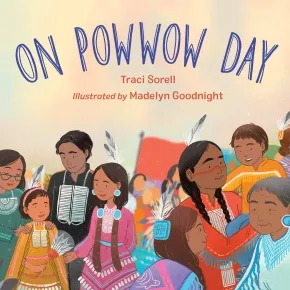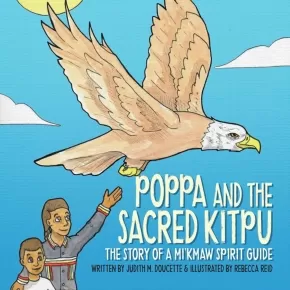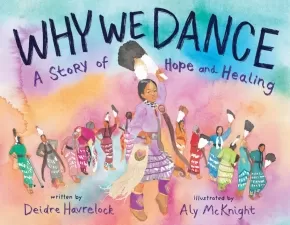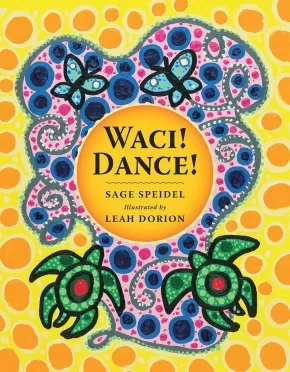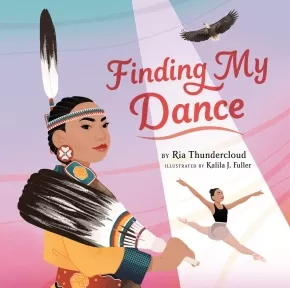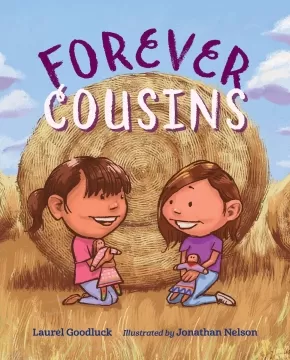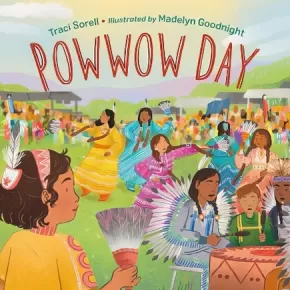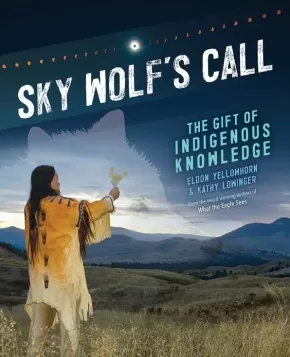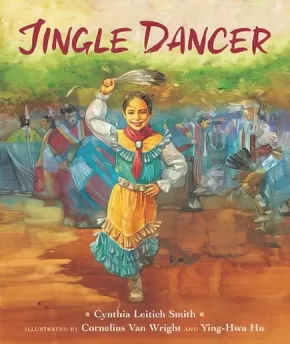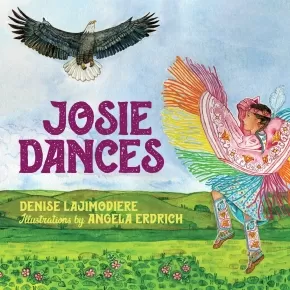
Ceremonies
16
-
30
of
53 Results;
Sort By
Go To
of 4
On Powwow Day (BB)
$10.99
Artists:
Format:
Board Book
Text Content Territories:
Indigenous American; Native American; Cherokee; Cherokee Nation (Cherokee Nation of Oklahoma);
Grade Levels: Preschool;
ISBN / Barcode: 9781623545765
Synopsis:
Synopsis:
In this board book by best-selling Native author Traci Sorell, discover colors, sounds, and counting from one to ten on powwow day!
This eye-catching, interactive board book is sure to keep toddlers engaged. Count one through ten as you make your way through the day of the powwow, looking for colors, family members, jingle dresses, musical instruments, and tribal citizens in this introduction to a traditional Native event.
An award-winning children's picture book adapted to be ready for little listeners in a warm and vibrant board book edition.
Reviews
"A colorful counting book engages children to identify the different visual elements that occur on powwow day. From the car that vrooms to the shaking shiny jingle cones, the exciting expressions catch more beyond the eye. The rainbow palette is shown off in organic and youthful design work. Every number from one to ten has a corresponding color, attached to a powwow day element. Readers can identify and count these elements, from the gray feathers on regalia to the bright moccasins. VERDICT This delightful picture book allows Indigenous children to connect with and feel pride in the abundance of powwow participation, and gives all readers a great counting book full of cultural imagery."—School Library Journal, starred review
Educator Information
Recommended for ages 3 and under.
Additional Information
20 pages | 5.88" x 5.88" | Board Book
Poppa and the Sacred Kitpu
$18.95
Artists:
Format:
Paperback
Text Content Territories:
Indigenous Canadian; First Nations; Mi'kmaq;
ISBN / Barcode: 9781774571859
Synopsis:
Synopsis:
After being invited into his grandson’s school to share his wisdom and knowledge of his traditional Mi’kmaw culture in Poppa and His Drum, Poppa is happy to return as a respected Indigenous Elder and Knowledge Keeper.
In this second book of the Poppa series, we find Poppa giving his next gin’masuti (lesson in our culture) to his grandson, François, and his friends, Paul and Joe.
The boys have an important art project to complete for school and are not sure what to do. While spending the afternoon on a beach adventure with Poppa, the boys get to learn about the Sacred Kitpu (Bald Eagle) and why it’s so important to our Indigenous People.
Poppa engages the children with eager imaginations of how the Sacred Kitpu is not only a powerful spirit guide, but also represents the Spirit of the Creator among us. It is the messenger between Mother Earth and the Spirit World, whispering to the Creator our prayers, touching the face of the Creator with its wing.
Poppa teaches the children through mystic wonder how we use the Sacred Kitpu feather in many different cultural ceremonies. He embraces their eagerness to learn and shares the tradition of smudging, using the Kitpu feather along with Sacred Medicines that burn in a smudge bowl to purify our body, mind, and spirit.
The children delight in discovering Poppa’s never-spoken-of regalia treasures that once belonged to his grandfather and decide to commemorate their art project to the Sacred Kitpu.
Poppa is invited back to the class to award the winning medal to the winners of the arts project. He is proud to present the medals to happy children who truly understand and appreciate the importance of the role the Sacred Kitpu plays in our Mi’kmaw culture and heritage. Poppa and the Sacred Kitpu will delight and surprise the reader with fun and teachings given by the love of a Poppa who is cherished by his community for being such a wonderful Mi’kmaw Elder.
Educator & Series Information
Recommended for ages 5 to 12.
This book is the second book in the Poppa series, following Poppa and His Drum.
Additional Information
9.00" x 9.00" | Paperback
Why We Dance: A Story of Hope and Healing
$23.99
Artists:
Format:
Hardcover
Text Content Territories:
Indigenous American; Indigenous Canadian;
ISBN / Barcode: 9781419756672
Synopsis:
Synopsis:
From Indigenous creative team Deidre Havrelock and Aly McKnight comes a powerful and exuberant story about the heritage, joy, and healing power of the Jingle Dress Dance—a perfect read-aloud picture book.
It’s a special day—the day of the Jingle Dress Dance! Before the big powwow, there’s a lot to do: getting dressed, braiding hair, packing lunches, and practicing bounce-steps. But one young girl gets butterflies in her stomach thinking about performing in front of her whole community. When the drumbeats begin, though, her family soothes her nerves and reminds her why she dances.
Emerging historically in response to the global influenza pandemic of 1918–19, the Jingle Dress Dance is a ceremonial dance of healing and prayer that still thrives today in many Indigenous and First Nations communities across North America. Lyrically and rhythmically written with lush, full-color illustrations, Why We Dance is a joyous celebration of a proud Indigenous tradition that inspires hope, resilience, and unity.
Educator Information
Recommended for ages 4 to 8.
Additional Information
40 pages | 11.00" x 8.50"| Hardcover
Benjamin's Thunderstorm
$21.99
Artists:
Format:
Hardcover
Text Content Territories:
Indigenous Canadian; First Nations; Cree (Nehiyawak);
ISBN / Barcode: 9781525303203
Synopsis:
Synopsis:
A thunderstorm evokes a boy's family traditions, in this rainy-day story from award-winning author Melanie Florence.
Benjamin loves the rain. He loves splashing through puddles in his bright yellow rain boots and watching the colors of a rainbow in the water as they ripple around his feet. But most of all, Benjamin loves thunder. To him, thunder --- piyêsiwak --- sounds like his grandfather's drum. It calls to him, like the songs his grandfather plays while his father and other powwow dancers spin and step in time to the drumbeat. As Benjamin hears the thunder rumble overhead, he imagines himself as a powwow dancer. He spins, he taps his feet and he lifts his knees. Faster and faster he twirls, delighted by and filled with the rhythm of piyêsiwak.
This artfully written story from award-winning author Melanie Florence celebrates both the universal joys of playing in the rain and the connections to family traditions that center and ground us. Elements of Cree powwow culture and Cree words for colors and weather are interwoven into the story, with a pronunciation guide in the back matter.
The vibrant and eye-catching art by Hawlii Pichette, inspired by the scenery of northern Ontario, adds drama to the pages. This inviting picture book makes a perfect read-aloud for a rainy day, as well as an excellent introduction to Cree cultural traditions, local communities and experiencing nature firsthand.
Educator & Series Information
Recommended for ages 3 to 7.
This book is available in French: Benjamin, au rythme du tonnerre
This book is part of the Benjamin Outdoors series. From dancing in the rain with thunder for a drum to planting a vegetable garden with his mom, Benjamin loves being in nature. With evocative text and vibrant art, this delightful picture book series celebrates the joys of spending time outdoors and weaves in nature-related Cree words.
Additional Information
32 pages | 10.00" x 8.50" | Hardcover
Powwow Dancing With Family (PB)
 $16.95
$16.95

Artists:
Format:
Paperback
Text Content Territories:
Indigenous Canadian; First Nations; Salish; Interior Salish; Secwepemc (Shuswap);
ISBN / Barcode: 9781771746281
Synopsis:
Synopsis:
Drumming, singing, and dancing are all part of being at a Powwow. Perry and his family travel all over North America to participate in these family and community gatherings. Join Perry’s two boys as they share their treasured memories of being at Powwows with their family and learning how to dance.
Reviews
“Lavishly illustrated with photographs, vivid sketches, and ledger art, Powwow Dancing With Family provides a detailed description of each stage of the Powwow, historical and contemporary aspects of the Powwow, and pays homage to Indigenous culture and customs. This informative resource will support studies of Indigenous culture, history, traditions, community, art, and family lifestyle.” – ERAC Review, May 2019
Educator Information
Includes three pages of educational material on Powwows with information found under these headings:
- What is a Powwow?
- Powwow Regalia
- Powwow Dances
About Perry Smith's Ledger Art:
Ledger Art is an art form that was developed in the mid 1800s to early 1900s by the Plains First Nations during a time when reserves were being established across North America. The ledger books were acquired in trade, war, or raids. New art supplies were also introduced: coloured pencils, crayons, and occasionally water paints. The new supplies were favoured by artists over the traditional bone and stick brushes. Many of the artworks within these ledger books display a traditional way of life, before assimilation. Today these artworks are greatly valued for the historical perspective that they offer.
Additional Information
32 pages | 8" x 8" | ISBN: 9781771746281 | Paperback
Suliewey: The Sequel to My Indian
$16.95
Format:
Paperback
Text Content Territories:
Indigenous Canadian; First Nations; Beothuk; Mi'kmaq;
ISBN / Barcode: 9781550819885
Synopsis:
Synopsis:
Suliewey: The Sequel to My Indian continues the story of Mi’kmaw guide Sylvester Joe, whose traditional name is Suliewey, as he seeks out the last remaining Beothuk community.
In My Indian, Sylvester was hired by William Cormack in 1822 to guide him across Newfoundland in search of Beothuk encampments. In fact, he followed the advice of his Elders and guided Cormack away from the Beothuk.
In this sequel, having parted ways with Cormack at St. George’s Bay, Sylvester decides to go out on his own, in search of the winter camp of the last of the remaining Beothuk.
Written as fiction, by two Mi’kmaq authors, Suliewey: The Sequel to My Indian supports Mi’kmaq oral history of friendly relationships with the Beothuk.
The novel reclaims the settler narrative that the Beothuk and the Mi’kmaq of Newfoundland were enemies and represents an existing kinship between the Mi’kmaq and the Beothuk.
Rich in oral history, the descriptions of traditional ceremonies and sacred medicines, the use of Mi’kmaw language, and the teachings of two-spirit place readers on the land and embed them in the strong relationships described throughout the book.
Educator & Series Information
Recommended for ages 12 to 14.
This is the second book in the My Indian series.
Additional Information
232 pages | 5.25" x 8.00" | b&w illustrations | Paperback
232 pages | 5.25" x 8.00" | b&w illustrations | Paperback
Waci! Dance! (1 in stock, in Reprint)
$23.95
Artists:
Format:
Hardcover
Text Content Territories:
Indigenous American; Native American; Sioux; Lakota; Hunkpapa; Indigenous Canadian; First Nations; Cree (Nehiyawak); Plains Cree; Beardy's and Okemasis' Cree Nation;
ISBN / Barcode: 9780889957275
Synopsis:
Synopsis:
A mother — the author of this story — shares Lakota cultural experiences with her daughter, introducing her to waci (dance) as a way to celebrate life. Wacipi (powwow), where the dancing occurs, is a setting for Indigenous song, dance, regalia, food and crafts.
A warm, family story for all ages, Waci! Dance! visually embraces the joy of being together and caring for each other. (A glossary and author's note are included.)
Educator Information
Recommended for ages 4 to 9.
Additional Information
24 pages | 9.00" x 10.00" | Hardcover
Dancing With Our Ancestors
$21.95
Artists:
Format:
Hardcover
Text Content Territories:
Indigenous Canadian; First Nations; Tlingit; Haida; Tsimshian (Ts'msysen); Indigenous American; Alaska Native; Tsimshian; Tlingit; Haida;
ISBN / Barcode: 9781774920244
Synopsis:
Synopsis:
Learn about the cultural significance of the Haida potlatch through the sights, sounds, and dances of this once-banned ceremony.
In this tender picture book, Sara Florence Davidson transports readers to the excitement of a potlatch in Hydaburg, Alaska—her last memory of dancing with her late brother.
It feels like my brother and I have always known how to sing the songs and dance the dances of our Haida ancestors. Unlike our father, we were born after the laws that banned our cultural practices were changed. The potlatch ban did not exist during our time, so we grew up dancing and singing side by side.
The invitations have been sent. The food has been prepared. The decorations have been hung. And now the day of the potlatch has finally arrived! Guests from all over come to witness this bittersweet but joyful celebration of Haida culture and community.
Written by the creators of Potlatch as Pedagogy, this book brings the Sk'ad'a Principles to life through the art of Janine Gibbons.
Educator & Series Information
Recommended for ages 6 to 8.
This book is part of the Sk'ad'a Stories series.
Additional Information
40 pages | 8.12" x 9.00" | Hardcover
Finding My Dance
$24.99
Artists:
Format:
Hardcover
Text Content Territories:
Indigenous American; Native American; Ho-Chunk (Winnebago); Sandia Pueblo;
ISBN / Barcode: 9780593093894
Synopsis:
Synopsis:
In her debut picture book, professional Indigenous dancer Ria Thundercloud tells the true story of her path to dance and how it helped her take pride in her Native American heritage.
At four years old, Ria Thundercloud was brought into the powwow circle, ready to dance in the special jingle dress her mother made for her. As she grew up, she danced with her brothers all over Indian country. Then Ria learned more styles--tap, jazz, ballet--but still loved the expressiveness of Indigenous dance. And despite feeling different as one of the only Native American kids in her school, she always knew she could turn to dance to cheer herself up.
Follow along as Ria shares her dance journey--from dreaming of her future to performing as a professional--accompanied by striking illustrations that depict it while bringing her graceful movements to life.
Reviews
"A warmly illustrated memoir of dance and culture, this will have broad appeal about using art for expression and to overcome difficulties." —School Library Journal, starred review
"A moving picture book about the resilience one can find in one’s cultural inheritance." —Kirkus Reviews
Educator Information
Recommended for ages 4 to 8.
Additional Information
40 pages | 10.44" x 10.31" | Hardcover
Forever Cousins
$21.99
Format:
Hardcover
Text Content Territories:
Indigenous American; Native American;
ISBN / Barcode: 9781623542924
Synopsis:
Synopsis:
In this Native American story, Kara and Amanda are best-friend cousins. Then Kara leaves the city to move back to the Rez. Will their friendship stay the same?
Kara and Amanda hate not being together. Then it's time for the family reunion on the Rez. Each girl worries that the other hasn't missed her. But once they reconnect, they realize that they are still forever cousins. This story highlights the ongoing impact of the 1950s Indian Relocation Act on Native families, even today.
This tender story about navigating change reminds readers that the power of friendship and family can bridge any distance.
Awards
- American Indian Youth Literature Award Winner
Reviews
"Amanda loves purple, while Kara’s favorite is pink, but “they agree that sunflowers are beautiful, powwow dancing is fun, and chokecherry jam on toast is the best.” When the time comes for Kara’s family to leave, both girls’ parents assure them that the family will be together again next summer at the reunion. A year passes, and the cousins miss each other very much but keep in touch by phone and through letters. When it’s time for the reunion on the reservation, the families make preparations: Amanda’s family packs and gets the GPS set for the two-day drive; Kara’s family makes welcoming signs, and her dad hangs a picture of the family tree. But the girls are nervous: Will they still be friends? In an author’s note, Goodluck explains that in the past, many Native families have faced separations; she cites the Indian Relocation Act of 1956 as one cause. Nevertheless, she emphasizes that they still maintain close relationships due to shared family and tribal values. This matter-of-fact yet poignant story brings that bond to vivid life as the girls realize that no matter what, they are “forever cousins.” The illustrations rely on a muted palette, featuring appealing characters with large heads. Cultural references are scattered throughout, like the dolls made by the girls’ magúu (grandmother), powwow dancing, and a Hidatsa naming ceremony. Children facing separations of their own will find this reassuring. A sweet story of friendship, family, and community. "—Kirkus Reviews
Educator Information
Recommended for ages 4 to 7.
Additional Information
32 pages | 8.00" x 10.00" | Hardcover
I Wish You Were Here
 $16.95
$16.95

Format:
Hardcover
Text Content Territories:
Indigenous Canadian; First Nations; Tsimshian (Ts'msysen); Haida;
ISBN / Barcode: 9781771745727
Synopsis:
Synopsis:
Dear Jean,
I had a substitute teacher recently. He stood up for a girl wearing a cedar hat when she was told to take it off by the vice-principal…
Even though Jean and Michael come from different cultural backgrounds and live far apart, they are best friends. To keep in touch, they write letters. Read their letters to discover what Jean and Michael do when they see and experience racial prejudice in their communities.
I Wish You Were Here is based on the authors' childhood experiences as pen pals in Haida Gwaii and Terrace in northern British Columbia. The book explores themes of friendship, culture, family, and community. It also addresses some tough issues, such as racism and intolerance, and explores ways to respond proactively. Included are resources and discussion questions to encourage further learning and reflection.
Reviews
“This lovely book explores healthy strategies for addressing racism and discrimination, including ceremonies, art, and intercultural allies. It is necessary reading for fostering the reconciliation and Indigenous resurgence that is imperative for our collective growth and enlightenment.” – Terri-Lynn Williams-Davidson, musician, author, activist, artist, and lawyer
“This book helps us to empower our children and each other in the important work of recognizing, talking about, and working through acts of racism.” – Severn Cullis-Suzuki, lifelong activist for intergenerational justice
Educator Information
Recommended for grades 3 to 7.
This middle-grade picture book includes discussion questions, a glossary, and additional resources for further learning and reflection.
Curriculum Connections & Keywords: Reconciliation, Indigenous Education, Social Awareness and Responsibility, Social Studies, Allyship, Racism, Anti-Racism, Discrimination, Social Justice, Racial Injustice, Haida, Haida Gwaii, Gwaii Haanas National Park, Tsimshian, Terrace, Letter Writing, Pen Pals, Friendship, Diversity, Child Empowerment, Advocacy, Inclusivity.
This book provides readers the opportunity to look at racism and discrimination through two different cultural lenses. It's a teaching tool to initiate conversations about issues such as racism, discrimination, and reconciliation.
In the video below, Erica Jean Reid Gidin Jaad shares how to pronounce Haida and Tsimshian words in I Wish You Were Here.
Additional Information
32 Pages | 6.5" x 9.5" | Hardcover | ISBN: 9781771745727
Powwow Day (HC) (9 in Stock)
$21.99
Artists:
Format:
Hardcover
Text Content Territories:
Indigenous American; Native American;
ISBN / Barcode: 9781580899482
Synopsis:
Synopsis:
In this uplifting, contemporary Native American story, River is recovering from illness and can't dance at the powwow this year. Will she ever dance again?
River wants so badly to dance at powwow day as she does every year. In this uplifting and contemporary picture book perfect for beginning readers, follow River's journey from feeling isolated after an illness to learning the healing power of community.
Additional information explains the history and functions of powwows, which are commonplace across the United States and Canada and are open to both Native Americans and non-Native visitors.
Awards
- 2023 Wyoming Buckaroo Award
Reviews
"A heartwarming picture book about the roles of courage, culture, and community in the journey of personal healing." —Kirkus Reviews
"A resonant, hopeful tale about the healing power of community and tradition" —Publishers Weekly
Educator Information
Recommended for ages 4 to 8.
Additional Information
32 pages | 9.44" x 9.31" | Hardcover
Sky Wolf's Call: The Gift of Indigenous Knowledge
$16.95
Format:
Paperback
Text Content Territories:
Indigenous Canadian; Indigenous American;
ISBN / Barcode: 9781773216294
Synopsis:
Synopsis:
From healing to astronomy to our connection to the natural world, the lessons from Indigenous knowledge inform our learning and practices today.
How do knowledge systems get passed down over generations? Through the knowledge inherited from their Elders and ancestors, Indigenous Peoples throughout North America have observed, practiced, experimented, and interacted with plants, animals, the sky, and the waters over millennia. Knowledge keepers have shared their wisdom with younger people through oral history, stories, ceremonies, and records that took many forms.
In Sky Wolf’s Call, award-winning author team of Eldon Yellowhorn and Kathy Lowinger reveal how Indigenous knowledge comes from centuries of practices, experiences, and ideas gathered by people who have a long history with the natural world. Indigenous knowledge is explored through the use of fire and water, the acquisition of food, the study of astronomy, and healing practices.
Reviews
"An authoritative tribute to Indigenous knowledge systems that's a must-have for every library and classroom." - Kirkus Reviews
“Sky Wolf’s Call has an astoundingly broad scope introducing Indigenous Traditional Ecological Knowledge (TEK) in North America from time immemorial to the current day … This fast paced celebration of Indigenous innovation and technology is riveting.” - The British Columbia Review
Educator Information
Interest Age: 11+
Grade: 6+
Reading Age: 11+
A Junior Library Guild Gold Standard Selection
Table of Contents
Author’s Note
1: Sky Wolf’s Call: The Gift of Indigenous Knowledge: Foundational ideas behind Indigenous Knowledge and the importance of retaining, maintaining, and learning this sacred knowledge.
2: Water Knowledge Ways: Water links us all and is sacred. Indigenous people have fought to protect the gift of water from harm, and the critical role it has played in transportation, agriculture, irrigation, and food.
3: Fire and Smoke Knowledge: Fire and smoke are great gifts, including the burning of tobacco. In sacred ceremonies, smoke connects our breath with the heavens. Fire cooks our food, helps grow our crops, and even keeps our waters clean. Cultural burns are used to benefit the land.
4: Indigenous Knowledge and Food Security: Sharing, growing, and receiving food with family, community, and visitors is both an honour and a tradition. By understanding the traditional practices of salmon fishing, clam gardens, planting and harvesting certain crops, or hunting buffalo, Indigenous Peoples have respected what Mother Earth has to offer.
5: Healing Knowledge Ways: The use of the medicine wheel and the sweat lodge have been used over centuries and still help sick and troubled people. Games such as lacrosse and chunkey have helped in building individual strength and community spirit. And braiding together Indigenous healing and western science has opened new learning opportunities.
6: Sky Knowledge: From the earliest Indigenous astronomers to modern astrophysicists, these sky watchers have studied the sacred gifts of the sky: the sun, moon, planets, and stars that have produced maps, calendars, beliefs about how to govern, and even directions for building homes.
7: Keeping the Knowledge: Indigenous People hold oral narratives in high esteem because that was the way knowledge passed from one generation to the next. People in North America recorded important events with symbols, pictographs (paintings), and petroglyphs (carvings). Language Keepers and Knowledge keepers are making sure that Indigenous knowledge is never forgotten.
8: Sky Wolf’s Call: Indigenous knowledge is based on the idea that this world is a gift. Understanding the idea of connections (the skies with the earth, people with animals, the practical with the spiritual) is an important lesson with the challenges of climate change, pandemics, and wars. The wisdom of Indigenous Knowledge can help the whole world.
Thanks and Acknowledgments
Glossary
Selected Reading
Sources and Contacts
Additional Information
120 pages | 7.50" x 9.25" | Paperback
Jingle Dancer (PB)
$12.50
Artists:
Format:
Paperback
Text Content Territories:
Indigenous American; Native American; Muscogee (Creek);
ISBN / Barcode: 9780063018112
Synopsis:
Synopsis:
The affirming story of how a contemporary Native American girl turns to her family and community to help her dance find a voice.
Jenna, a contemporary Muscogee (Creek) girl, loves the tradition of jingle dancing that has been shared by generations of women in her family, and she hopes to dance at the next powwow. But she has a problem—how will her dress sing if it has no jingles?
The cone-shaped jingles sewn to Grandma Wolfe's dress sing tink, tink, tink, tink.
Jenna's heart beats to the brum, brum, brum, brum of the powwow drum as she daydreams about the clinking song of her grandma's jingle dancing.
The warm, evocative watercolors of Cornelius Van Wright and Ying-Hwa Hu complement author Cynthia Leitich Smith's lyrical text in this picture book. Perfect for classroom and library sharing.
Educator Information
Suggested Ages: 4-8.
Additional Information
32 pages | 9.25" x 11.00" | Paperback
Josie Dances
$23.99
Format:
Hardcover
Text Content Territories:
Indigenous American; Native American; Anishinaabeg; Ojibwe (Chippewa); Turtle Mountain Anishinaabe;
ISBN / Barcode: 9781681342078
Synopsis:
Synopsis:
Josie dreams of dancing at next summer's powwow. But first she needs many special things: a dress, a shawl, a cape, leggings, moccasins, and, perhaps most important of all, her spirit name. To gather all these essential pieces, she calls on her mom, her aunty, her kookum, and Grandma Greatwalker. They have the skills to prepare Josie for her powwow debut.
As the months go by, Josie practices her dance steps while Mom stitches, Aunty and Kookum bead, and Grandma Greatwalker dreams Josie's spirit name. Josie is nervous about her performance in the arena and about all the pieces falling into place, but she knows her family is there to support her.
The powwow circle is a welcoming space, and dancers and spectators alike celebrate Josie's first dance. When she receives her name, she knows it’s just right. Wrapped in the love of her community, Josie dances to honor her ancestors.
In this Ojibwe girl's coming-of-age story, Denise Lajimodiere highlights her own daughter's experience at powwow. Elegant artwork by Angela Erdrich features not only Josie and her family but also the animals and seasons and heartbeat of Aki, Mother Earth, and the traditions that link Josie to generations past and yet to come.
Educator Information
Recommended for ages 3 to 7.
Additional Information
32 pages | 10.00" x 10.00" | Hardcover
Sort By
Go To
of 4

